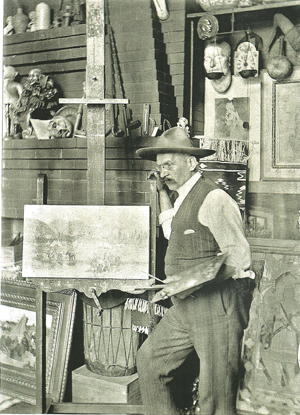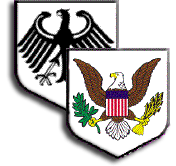Articles and Reviews
Don Heinrich Tolzmann, "John Hauser - A Cincinnati German Artist," Amerika-Woche (18/25 June 2012).
 In a new biography by E.P. Harris and Jerry Glenn tell the fascinating life of one of Cincinnati's well-known German-American artists: John Hauser. It also catalogs his numerous paintings. Beautifully illustrated with reproductions of his paintings, the work carries an interesting title: Straight White Shield: A Life and Works of John Hauser, with A Catalogue Raisonne (1859-1913) (MicroPress, 2012). The authors explain: "To his Indian friends, his canvas and his sketchbook make it seem that he has taken shelter behind a flat piece of armor, so that when they in turn adopt him into their tribe (the Oglala Sioux) in 1901 they dub him 'Straight White Shield.'"
In a new biography by E.P. Harris and Jerry Glenn tell the fascinating life of one of Cincinnati's well-known German-American artists: John Hauser. It also catalogs his numerous paintings. Beautifully illustrated with reproductions of his paintings, the work carries an interesting title: Straight White Shield: A Life and Works of John Hauser, with A Catalogue Raisonne (1859-1913) (MicroPress, 2012). The authors explain: "To his Indian friends, his canvas and his sketchbook make it seem that he has taken shelter behind a flat piece of armor, so that when they in turn adopt him into their tribe (the Oglala Sioux) in 1901 they dub him 'Straight White Shield.'"
Cincinnati is well known for its German heritage as being one of the three cities along with Milwaukee and St. Louis that formed the famed "German Triangle." All of them became major centers of German immigration and heritage, each developing numerous German districts and neighborhoods. All of them became well known also as major brewing centers, remaining so to this day. Historically they were also centers of German-American culture, with artists and authors reflecting German cultural influences in their works.
One such artist was the painter John Hauser who, like many German-American artists, had a pronounced love of the American West and sought to capture its beauty in his many paintings. As the authors note: "John Hauser, schooled in the academic tradition in Europe, made a conscious effort to paint the Indian." His initial studies in art in Cincinnati were continued in Munich at the Art Academy, after which he returned to Cincinnati, beginning a career as a teacher and artist. Often visiting Indian reservations in the American West, he named his home Pine Ridge after the Sioux Pine Ridge reservation.
The biography includes interesting texts of contemporary newspaper articles about the artist. One obituary, for example, from the Cincinnatier Volksblatt, notes: "The deceased was not only a total artist but also an exemplary German who tirelessly strove to provide access for German art in the local art scene. Mr. Hauser was the model of kindness and politeness and it was a pleasure to listen to him tell of his experiences with the red sons of the forest. His mouth is now silenced and his hand will paint no more. But his name lives on in his works, and when we list German-American artists, the name John Hauser will not be absent."
In addition to the biographical detail about Hauser, the authors catalog his many paintings in what will long serve as the definitive register of his works. Supplementing these illustrations are informative pictures of Hauser, showing him at work in his studio. Both authors are to be congratulated on the completion of this work, the result of years of research. It enhances and enriches our knowledge of the German cultural heritage of Cincinnati, Ohio and is an indication that there is still much more that can be explored regarding the life and works of German-American artists of the area. For further information contact the MicroPress of Bellevue, Kentucky (859-291-1412), or visit its website at: www.micropressbooks.com.
